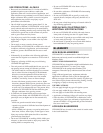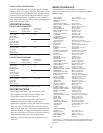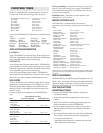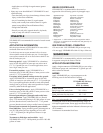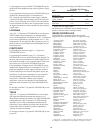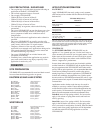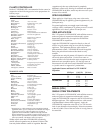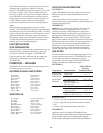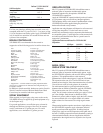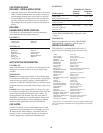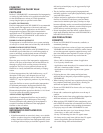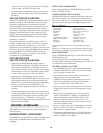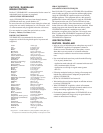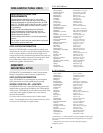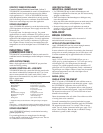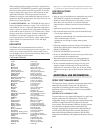
DuPont™ VELPAR® DF
Soil Description (Lb/Acre)
Loamy sand,
sandy loam 1 1/3 - 3
Loam,
silt loam,
sandy clay loam 2 2/3 - 4
Silt, silty clay loam,
clay loam,
sandy clay, silty clay,
clay 3 - 4
For first year plantings utilizing bare root stock, treat only
transplant stock that is 2 years old (2-0, 1-1) or more, except
(1-0) for Ponderosa and Jeffrey pines. Apply VELPAR® DF
only if rainfall has settled the soil around the base and root
systems of the transplants.
BRUSH CONTROLLED
VELPAR® DF is recommended for the control or
suppression of the following species in conifer release sites:
* Suppression – a visible reduction in plant population and/or
plant vigor as compared to an untreated area and generally not
accepted as control.
In addition to brush controlled, herbaceous species listed in
Weeds Controlled section of Release-Herbaceous Weed
Control may be controlled with these applications.
SPRAY EQUIPMENT
When applied as a liquid spray using water as the carrier,
VELPAR® DF may be applied by ground equipment or by
air (helicopter only).
For ground applications, use sufficient spray volume for
thorough and uniform coverage of the site to be treated,
usually a minimum of 25 gallons per acre. For aerial
applications, use a minimum of 5 gallons per acre.
GRID APPLICATION
Mix 2 2/3 pounds of VELPAR® DF with sufficient water to
make one gallon of suspension and thoroughly agitate.
Intermittent agitation may be required to maintain the
VELPAR® DF in suspension.
Apply the VELPAR® DF suspension directly to the soil surface
in a grid pattern using an exact delivery handgun applicator.
This equipment delivers a thin stream of predetermined volume.
VELPAR® DF should be applied during the period from
hardwood bud break to early summer.
Application rate and grid pattern will depend on soil texture and
woody plant composition. Use the lower rates on coarse
textured soils and when the major component of the hardwoods
are susceptible species. Use the high rates on fine-textured soils
and where weeds identified in the label as “partial control or
suppression” predominate.
Application Patterns and Rates For VELPAR® DF
Suspension
ML/Spot Grid (Ft) Lb/Acre
Coarse 0.5 3 X 4 1.3*
1.2 3 X 6 2
2.1 4 X 6 2.6
Medium/Fine 1.2 3 X 3 4
2.3 3 X 6 4
1.6 3 X 3 5.3
3.1 3 X 6 5.3
* Use on deep sands with pines four years or more of age.
BASAL (SOIL)
SINGLE STEM TREATMENT
Mix 2 2/3 pounds of VELPAR® DF with sufficient water to
make one gallon of suspension and thoroughly agitate. Apply
the VELPAR® DF suspension with an exact-delivery handgun
applicator. This equipment delivers a thin stream of
predetermined volume when triggered. Apply the VELPAR®
DF suspension at the rate of 2 to 4 ml for each inch of stem
diameter at breast height. Direct the treatment to the soil within
3 feet of the root collar of woody plants to be controlled.
For multi-stemmed and low-growing brush that have stem
diameters that are difficult to determine, apply the VELPAR®
DF suspension at the rate of 2 to 4 ml per 3 feet of canopy
width. For tall, slender (columnar) brush types, apply 4 to 8 ml
per 3 feet of height. Base the rate on whichever canopy
dimension is greater (width or height). Apply the lower volumes
for coarse textured soils or low organic matter soils and the
higher volumes for fine textured soils or high organic matter
soils.
When treating brush that requires more than a single delivery of
the VELPAR® DF suspension, apply subsequent deliveries
equally spaced around the target plant. If treating brush on
sloping sites, apply most of the suspension on the uphill side of
the stem. If treating resprouts from brush disturbed by cutting or
other mechanical methods, the rate of application should be
proportional to the original tree size, not just the size of sprout
regrowth.
Ash Fraxinus spp
Aspen, big tooth Populus grandidentata
Aspen, trembling Populus tremuloides
Birch Betula spp
Elder, box Acer negundo
Brambles Rubus spp
Cherry, black Prunus serotina
Cherry, pin Prunus pensylvanica
Deerbrush Ceanothus integerrimus
Dogwood, flowering* Cornus florida
Elm Ulmus spp
Hawthorn Crataegus spp
Hazel Corylus spp
Honeysuckle* Lonicera spp
Manzanita, Greenleaf Arctostaphylos patula
Maple, red* Acer rubrum
Oaks Quercus spp
Poplar, balsam Populus balsamifera
Snowbrush (varnishleaf) Ceanothus velutinus
Sourwood* Oxydendrum arboretum
Sweetgum Liquidambar spp
Willows Salix spp
15



